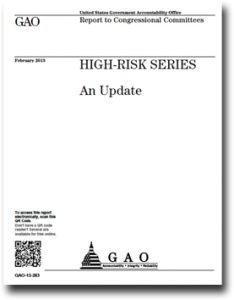 Since 1990, the Government Accountability Office has been reporting on federal government operations that it identifies as “high risk” because of their greater vulnerabilities to fraud, waste and mismanagement; its biennial reports aim to help the federal government identify problems that keep it from operating economically, efficiently and effectively. “Managing Federal Real Property” was added to the list in 2003, and the latest in this series of reports, released yesterday (Thursday, February 14), once again cites it as a high-risk area.
Since 1990, the Government Accountability Office has been reporting on federal government operations that it identifies as “high risk” because of their greater vulnerabilities to fraud, waste and mismanagement; its biennial reports aim to help the federal government identify problems that keep it from operating economically, efficiently and effectively. “Managing Federal Real Property” was added to the list in 2003, and the latest in this series of reports, released yesterday (Thursday, February 14), once again cites it as a high-risk area.
While recognizing that “the government has given high level attention to this issue and has made progress in real property management,” High-Risk Series: An Update (GAO-13-283) states that “the underlying challenges that hamper reform remain.” These challenges include “effectively managing excess and underutilized property, an overreliance on leasing, and protecting federal facilities,” as well as a lack of reliable data, competing stakeholder interests and legal requirements such as those related to environmental cleanup.
The report concludes that GSA has lost $200 million since 2005—$75 million of which was spent in 2011 alone—on unnecessary leasing deals. (It reached that figure by calculating the money GSA spent leasing property in markets in which the government already owns underutilized property.) It also notes that GSA is losing money even after collecting rent from the agencies to which it provides leased space. And it faults federal agencies for not consolidating into government-owned properties, while also recognizing that “agencies do not have a strong understanding of real property held by other agencies and may lack the authority or expertise to lease underutilized property to other federal agencies.”
The report concludes that while “multiple administrations have committed to a more strategic approach toward managing real property … their efforts have not yet fully addressed the underlying challenges.” Examples of those efforts include President Obama’s June 2010 directive calling on federal civilian agencies to achieve $3 billion in cost savings by the end of FY 2012, in part through better management of excess properties, and the administration’s May 2011 proposal of legislation—the Civilian Property Realignment Act (CPRA)—that would have established a framework for disposing of and consolidating such property. While the $3 billion goal may have been reached, the report claims that “the actual savings associated with selling excess and better managing underutilized property are not transparent and may be overstated.” The CPRA and other real property reform legislation, it notes, “have not been enacted.”
